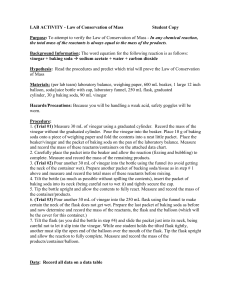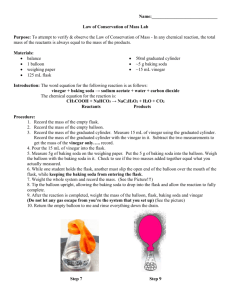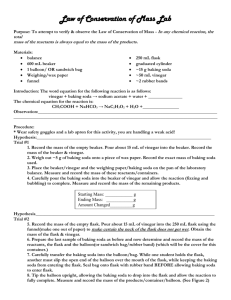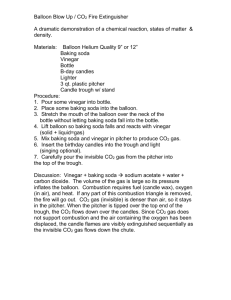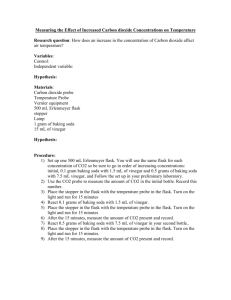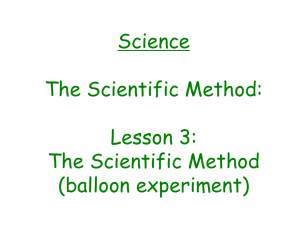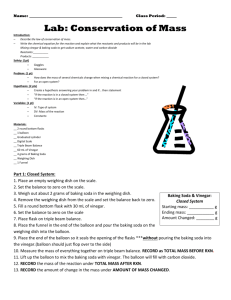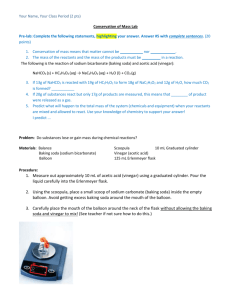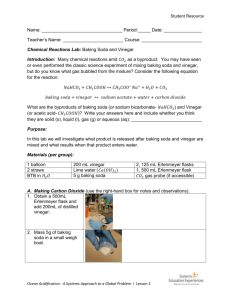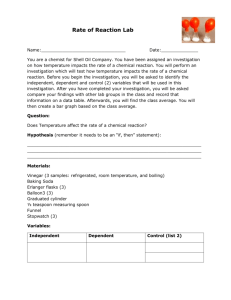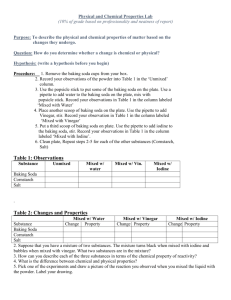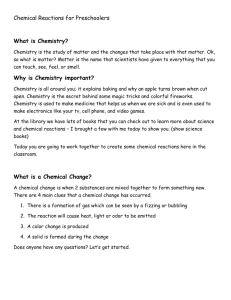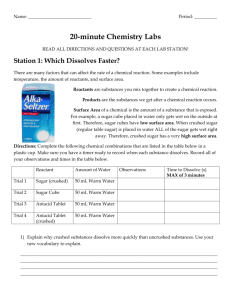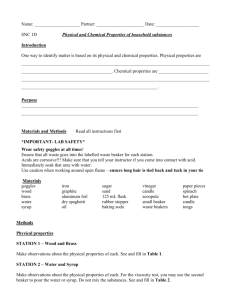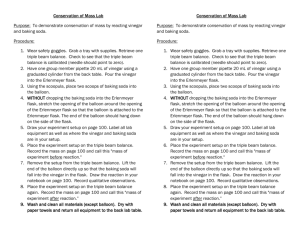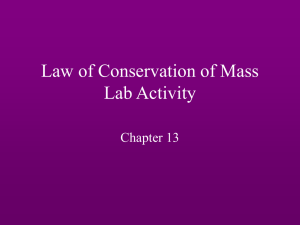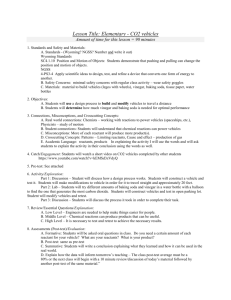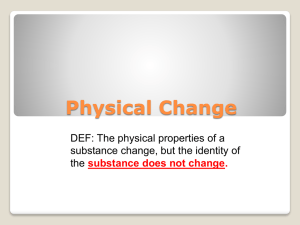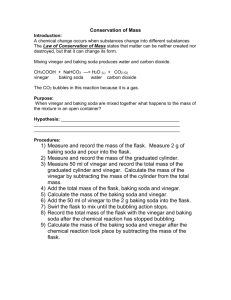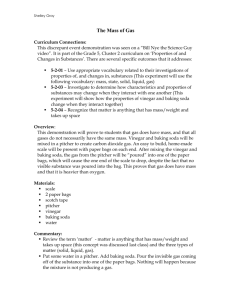Law Of Conservation Of Mass Lab
advertisement
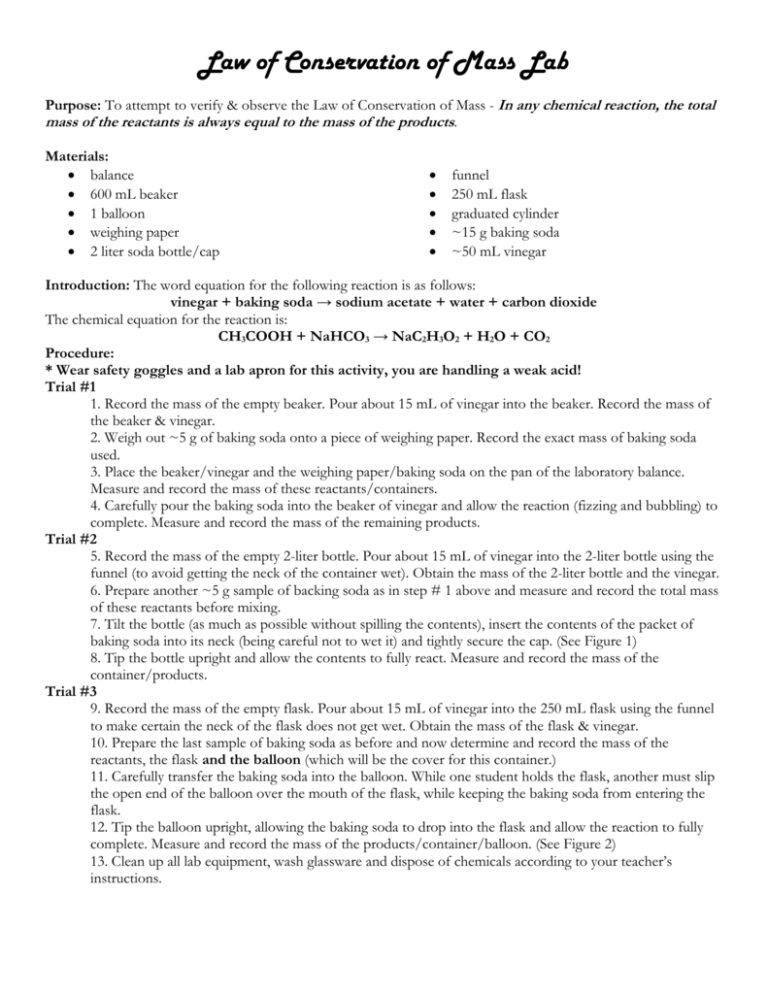
Law of Conservation of Mass Lab Purpose: To attempt to verify & observe the Law of Conservation of Mass - In any chemical reaction, the total mass of the reactants is always equal to the mass of the products. Materials: balance 600 mL beaker 1 balloon weighing paper 2 liter soda bottle/cap funnel 250 mL flask graduated cylinder ~15 g baking soda ~50 mL vinegar Introduction: The word equation for the following reaction is as follows: vinegar + baking soda → sodium acetate + water + carbon dioxide The chemical equation for the reaction is: CH3COOH + NaHCO3 → NaC2H3O2 + H2O + CO2 Procedure: * Wear safety goggles and a lab apron for this activity, you are handling a weak acid! Trial #1 1. Record the mass of the empty beaker. Pour about 15 mL of vinegar into the beaker. Record the mass of the beaker & vinegar. 2. Weigh out ~5 g of baking soda onto a piece of weighing paper. Record the exact mass of baking soda used. 3. Place the beaker/vinegar and the weighing paper/baking soda on the pan of the laboratory balance. Measure and record the mass of these reactants/containers. 4. Carefully pour the baking soda into the beaker of vinegar and allow the reaction (fizzing and bubbling) to complete. Measure and record the mass of the remaining products. Trial #2 5. Record the mass of the empty 2-liter bottle. Pour about 15 mL of vinegar into the 2-liter bottle using the funnel (to avoid getting the neck of the container wet). Obtain the mass of the 2-liter bottle and the vinegar. 6. Prepare another ~5 g sample of backing soda as in step # 1 above and measure and record the total mass of these reactants before mixing. 7. Tilt the bottle (as much as possible without spilling the contents), insert the contents of the packet of baking soda into its neck (being careful not to wet it) and tightly secure the cap. (See Figure 1) 8. Tip the bottle upright and allow the contents to fully react. Measure and record the mass of the container/products. Trial #3 9. Record the mass of the empty flask. Pour about 15 mL of vinegar into the 250 mL flask using the funnel to make certain the neck of the flask does not get wet. Obtain the mass of the flask & vinegar. 10. Prepare the last sample of baking soda as before and now determine and record the mass of the reactants, the flask and the balloon (which will be the cover for this container.) 11. Carefully transfer the baking soda into the balloon. While one student holds the flask, another must slip the open end of the balloon over the mouth of the flask, while keeping the baking soda from entering the flask. 12. Tip the balloon upright, allowing the baking soda to drop into the flask and allow the reaction to fully complete. Measure and record the mass of the products/container/balloon. (See Figure 2) 13. Clean up all lab equipment, wash glassware and dispose of chemicals according to your teacher’s instructions. Figure 1 Figure 2 Results: Calculate percent error for each trial, initial mass vs. final mass of reactants & products. Inquiry/Analysis Questions: 1. What evidence was there that a chemical reaction occurred? 2. How did the final mass of the system compare with the initial mass of the system for each trial? If the law of conservation of mass was violated, justify your results. (Hint for Trial#3: Think of the helium-filled balloons you once had which were floating near the ceiling in the evening, but resting on the floor in the morning.) 3. Indicate the state of matter for each reactant and product. 4. How else could you have tested the law of conservation of matter for this reaction? What other experimental designs could you have implemented? Explain your revised procedure.

